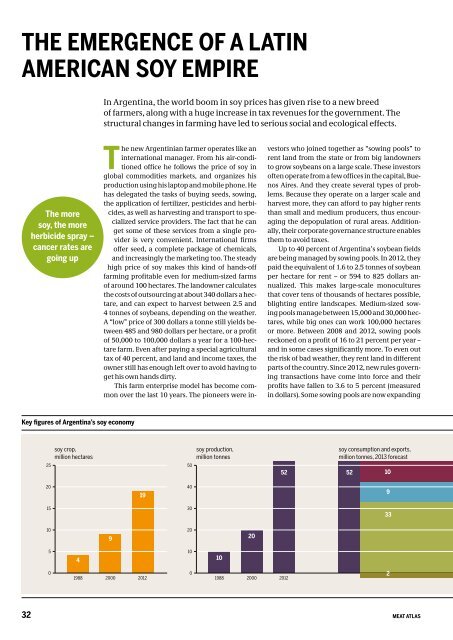1jjtwKx
1jjtwKx
1jjtwKx
You also want an ePaper? Increase the reach of your titles
YUMPU automatically turns print PDFs into web optimized ePapers that Google loves.
THE EMERGENCE OF A LATINAMERICAN SOY EMPIREIn Argentina, the world boom in soy prices has given rise to a new breedof farmers, along with a huge increase in tax revenues for the government. Thestructural changes in farming have led to serious social and ecological effects.The moresoy, the moreherbicide spray –cancer rates aregoing upThe new Argentinian farmer operates like aninternational manager. From his air-conditionedoffice he follows the price of soy inglobal commodities markets, and organizes hisproduction using his laptop and mobile phone. Hehas delegated the tasks of buying seeds, sowing,the application of fertilizer, pesticides and herbicides,as well as harvesting and transport to specializedservice providers. The fact that he canget some of these services from a single provideris very convenient. International firmsoffer seed, a complete package of chemicals,and increasingly the marketing too. The steadyhigh price of soy makes this kind of hands-offfarming profitable even for medium-sized farmsof around 100 hectares. The landowner calculatesthe costs of outsourcing at about 340 dollars a hectare,and can expect to harvest between 2.5 and4 tonnes of soybeans, depending on the weather.A “low” price of 300 dollars a tonne still yields between485 and 980 dollars per hectare, or a profitof 50,000 to 100,000 dollars a year for a 100-hectarefarm. Even after paying a special agriculturaltax of 40 percent, and land and income taxes, theowner still has enough left over to avoid having toget his own hands dirty.This farm enterprise model has become commonover the last 10 years. The pioneers were investorswho joined together as “sowing pools” torent land from the state or from big landownersto grow soybeans on a large scale. These investorsoften operate from a few offices in the capital, BuenosAires. And they create several types of problems.Because they operate on a larger scale andharvest more, they can afford to pay higher rentsthan small and medium producers, thus encouragingthe depopulation of rural areas. Additionally,their corporate governance structure enablesthem to avoid taxes.Up to 40 percent of Argentina’s soybean fieldsare being managed by sowing pools. In 2012, theypaid the equivalent of 1.6 to 2.5 tonnes of soybeanper hectare for rent – or 594 to 825 dollars annualized.This makes large-scale monoculturesthat cover tens of thousands of hectares possible,blighting entire landscapes. Medium-sized sowingpools manage between 15,000 and 30,000 hectares,while big ones can work 100,000 hectaresor more. Between 2008 and 2012, sowing poolsreckoned on a profit of 16 to 21 percent per year –and in some cases significantly more. To even outthe risk of bad weather, they rent land in differentparts of the country. Since 2012, new rules governingtransactions have come into force and theirprofits have fallen to 3.6 to 5 percent (measuredin dollars). Some sowing pools are now expandingKey figures of Argentina’s soy economysoy crop,million hectares25soy production,million tonnes5052soy consumption and exports,million tonnes, 2013 forecast52 102019409153033109202054101001988 2000 201201988 2000 2012232MEAT ATLAS


